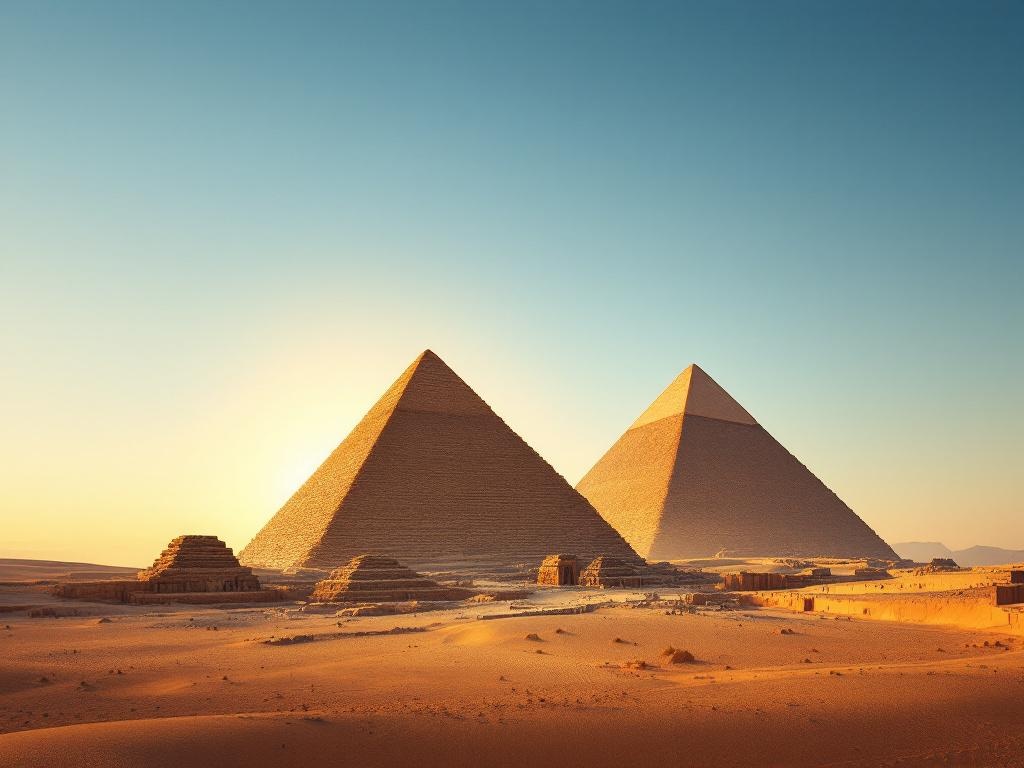Exploring the Pyramids of Giza in Egypt
Journey back 5,000 years to the Giza Plateau near Cairo, where the majestic Pyramids stand as testaments to ancient Egyptian ingenuity. Discover the secrets of the Great Pyramid of Khufu, the largest and oldest, along with the Pyramids of Khafre and Menkaure. Explore the mysteries within their chambers, marvel at the Sphinx, and uncover the rich history of the Giza Necropolis. Plan your adventure now, from ticket prices and opening times to the best ways to experience this ancient wonder. Uncover the mysteries of the pharaohs – explore the Pyramids of Giza!
Important information

- The Giza Pyramids, built nearly 5,000 years ago as tombs for pharaohs, are located on the Giza Plateau near Cairo, Egypt.
- The three main pyramids are Khufu (the largest), Khafre (second largest), and Menkaure (smallest). The Great Sphinx, a massive limestone statue, is also part of the complex.
- The pyramids contain chambers, including the King’s Chamber, for burial rites and the afterlife journey.
- The site is open daily from 8:00 AM to 5:00 PM. Ticket prices vary: 200 EGP for general access, 400 EGP for Khufu, and 80 EGP for the Solar Boat Museum.
- The best time to visit is October to April for cooler weather. Taxis, Uber, buses, and private cars provide access to the site.
Introduction to the Pyramids of Giza
Near Cairo, on Egypt’s Giza Plateau, the awe-inspiring Giza Pyramids stand as testaments to ancient ingenuity. Built nearly 5,000 years ago, these iconic structures mark the beginning of recorded history, serving as tombs for the pharaohs. Their immense scale and intricate design inspire wonder, offering a glimpse into a captivating past. The pyramids’ location on the Giza Plateau adds to the site’s historical and geographical significance, solidifying their status as enduring symbols of ancient Egypt’s power and sophistication. Before you travel, make sure you have the necessary visa or permits. Check the latest entry requirements here: Check if you need a visa or other travel documents.
The Giza Plateau: Location and Importance
The Giza Plateau, located on the west bank of the Nile near Cairo, rises from the desert. This elevated area is of immense historical significance, dominated by the imposing pyramids that attract tourists and researchers eager to explore ancient Egypt. The combination of the plateau’s location and these magnificent structures makes Giza a truly remarkable destination.
Historical Significance and Construction
The Giza pyramids, constructed nearly 5,000 years ago, are a testament to ancient ingenuity. The Great Pyramid, built around 2570 BC, reigned for 3,800 years as the world’s tallest man-made structure. Despite their prominence, much about these monuments remains shrouded in mystery. Exhibits and local guides offer valuable insights into the pyramids’ construction and profound cultural significance, unveiling the history and impact of these marvels of ancient Egypt.
The Three Main Pyramids
The Great Pyramid of Giza, the oldest and largest of the three pyramids, stands as a testament to Pharaoh Khufu’s reign. It was constructed during the Fourth Dynasty, around 2580-2560 BC. It dwarfs its neighbors.
The second largest pyramid honors Khufu’s son Khafre and is distinguished by its apex of casing stones. The smallest pyramid belongs to Khafre’s successor, Menkaure.
The Great Pyramid of Khufu
The Great Pyramid of Giza, also known as the Pyramid of Khufu, is the oldest and largest of the three pyramids in Giza. For over 3,800 years, it held the record as the tallest man-made structure in the world, originally reaching a height of 146.6 meters (481 feet). It served as the tomb of the Pharaoh Khufu.
Pyramid of Khafre
Located in Giza, the Pyramid of Khafre stands at an impressive 136.4 meters (448 feet) tall, second only to its neighboring pyramid. Its peak still retains some of its original smooth, white limestone casing, a testament to the structure’s original grandeur.
Built by Pharaoh Khafre, son of Khufu, the pyramid is the centerpiece of a larger complex. This complex includes a valley temple, a causeway, and the iconic Sphinx.
Pyramid of Menkaure
The Pyramid of Menkaure, the smallest of the three main Giza pyramids, stands approximately 65 meters (213 feet) tall. Its lower levels are clad in striking red granite, while the upper sections feature white Tura limestone. This mixed construction distinguishes it from the larger pyramids of Khufu and Khafre, which primarily consist of Tura limestone.
Other Notable Structures
The Great Sphinx, a colossal limestone statue of a mythical sphinx (lion’s body and human head), stands proudly on the Giza Plateau. Part of the Giza Necropolis, it’s often associated with the nearby pyramids. It is believed to have been built during the reign of Pharaoh Khafre (c. 2558–2532 BC) as a symbolic guardian.
The Great Sphinx
The Great Sphinx, a colossal limestone statue with a lion’s body and a human head, likely depicting Pharaoh Khafre, stands guard on the Giza plateau near the pyramids. This ancient wonder is among the world’s oldest and largest monolithic statues, a powerful symbol of ancient Egypt and its necropolis.
Inside the Pyramids
Within the Pyramids of Giza, chambers were designed for the afterlife. The King’s Chamber held the pharaoh’s sarcophagus, while others contained treasures and offerings for the deceased’s journey.
King’s Chamber and Burial Chambers
Deep within the Great Pyramid of Giza rests the granite King’s Chamber, Pharaoh Khufu’s final resting place. The pyramid also houses other burial chambers, including the Queen’s Chamber and a subterranean one, all vital for ancient Egyptian funeral rites. These chambers contained the pharaoh’s sarcophagus and treasures, reflecting the Egyptians’ belief in the afterlife.
Visiting the Pyramids of Giza
Planning a trip to the Giza Pyramids? Here’s the essential information.
Visiting Hours and Ticket Prices
The Pyramids are open daily from 8:00 AM to 5:00 PM. General admission is 200 EGP, but entering the Great Pyramid (Khufu) costs 400 EGP. A separate ticket (80 EGP) is required for the Solar Boat Museum.
Best Time to Visit
For the most comfortable experience, visit during the cooler months from October to April. To avoid large crowds and the midday heat, arrive early or late in the day.
Getting There and Accessibility
Getting there is easy with various transportation options, including taxis, Uber, and private cars. Public buses also run from Cairo and Giza. While the site offers some wheelchair accessibility, navigating the terrain can be challenging.
Tips for Your Visit
- Dress respectfully and wear comfortable shoes.
- Remember to bring water and sunscreen, especially during hotter months.
- Consider hiring a licensed guide to enhance your experience.
- Be wary of touts and scams, and purchase souvenirs only from authorized vendors.
- For your safety, stay within designated areas and follow instructions from security personnel.
Opening Hours and Entrance Fees
The Giza Pyramids complex is open daily from 8:00 am to 5:00 pm. General access to the Giza Plateau costs 200 EGP. For a closer look, explore the interior of the Great Pyramid of Khufu for an additional 400 EGP. The Pyramids of Khafre and Menkaure can also be explored inside, each for 100 EGP.
General Access
Giza Plateau: 200 EGP.
Pyramid Interiors
- Khufu: 400 EGP.
- Khafre: 100 EGP.
- Menkaure: 100 EGP.
Best Time to Visit
Escape the heat and explore the Pyramids of Giza between October and April, when temperatures range from a pleasant 15°C to 25°C (59°F to 77°F). While the midday sun can be strong, early mornings and late afternoons offer the most comfortable sightseeing conditions.
Transportation Options and Accessibility
Several convenient options are available for visiting the Pyramids of Giza, including:
- taxis,
- buses,
- private tours.
While access is generally good, pre-trip planning is recommended. Checking specific routes and available services is especially important.
Visitor Tips and Safety Guidelines
arrive early to avoid crowds and the midday sun.
pack water and snacks, as on-site options are limited. Please note that climbing the pyramids is prohibited for safety reasons.
Experiencing the Pyramids
Immerse yourself in history with the Sound and Light Show at the Pyramids of Giza, where multimedia storytelling brings the past to life.
Explore the magnificent pyramids with guided tours that offer valuable insights into their history, mythology, and construction.
Venture inside the pyramids to experience the ancient burial chambers firsthand (available on select tours).
Enjoy a unique perspective with a camel ride around the pyramids, offering a taste of the past.
Learn more about the pyramids’ history, construction, and cultural significance through informational displays and knowledgeable local guides.
Capture stunning panoramic views with the Giza Plateau and the Sphinx as breathtaking backdrops for unforgettable photo opportunities.
Plan your visit carefully, allowing ample time to explore the pyramids and surrounding areas.
Sound and Light Show
The Sound and Light show at the Pyramids of Giza is a captivating spectacle, illuminating these ancient wonders with narratives, music, and mesmerizing visual effects. This unique experience brings the history and mysteries of the pyramids to life.
Panoramic Points and Photography Tips
Capture breathtaking panoramic views of the Giza pyramids, a photographer’s paradise. Experiment with the light throughout the day, capturing their majesty from various angles. While sunrise and sunset offer the most dramatic hues, any time is ideal for exploring this ancient wonder. Don’t miss the stunning vistas of the Sphinx from the plateau.
Exploring Beyond the Pyramids
The Giza Necropolis, located near Cairo, is an ancient Egyptian burial ground surrounding the iconic Pyramids of Giza. It offers a captivating glimpse into the past. Archaeological discoveries at this site reveal intriguing details about ancient Egyptian burial rituals and their beliefs concerning the afterlife. Beyond the majestic pyramids, the Necropolis encompasses smaller pyramids, mastabas (ancient tombs), temples, and causeways. These structures further illuminate the history and culture of the Giza Plateau, creating a vibrant tapestry of this ancient world.
Giza Necropolis and Archaeological Findings
The Giza Necropolis is more than just pyramids. It’s a sprawling complex encompassing cemeteries, temples, and worker’s villages. Archaeological discoveries at the site offer a vibrant glimpse into ancient Egyptian life, illuminating their beliefs, daily routines, and intricate burial practices. Tombs reveal much about their beliefs in the afterlife. Artifacts like tools and pottery offer insights into their everyday existence. The Necropolis also holds clues to the pyramids’ construction, with discoveries like causeways and boat pits showcasing the massive undertaking involved and the rituals surrounding the pharaohs’ journey to the next world. This treasure trove of information continues to fascinate and educate us about this remarkable civilization.












